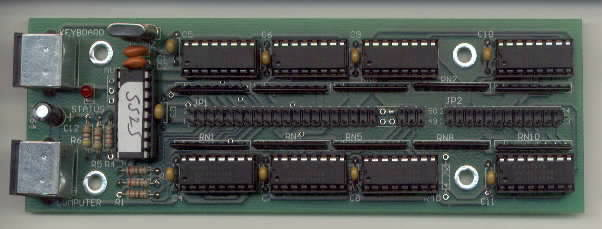MK40 / MK64
Low Cost Programmable Keyboard Encoders.

New Features:
- F7 key can now be programmed in the key map and macros.
- There are now three programmable key map banks (0, 1, 2) NEW BANK USAGE MANUAL
- Typematic function is supported (Repeats last key held down)
- Startup settings (Typematic and Shift keys can be saved in EEPROM)
- Macro scripts have been added (Up to 16 macros)
- Dual rotary joystick support (12 position Ikari Warrior style) NEW ROTARY MANUAL
Features:
- Can generate an alternate key set on seven of the inputs when when the "shift"
key is held down. Useful for sending game maintenance codes using existing controls
instead of using extra buttons and inputs for this task. The "shift" key
performs its normal function if none of the seven "shiftable" keys were pressed.
- 64 single wire dedicated digital inputs on MK64 (Poorly scanned picture above).
- 40 single wire dedicated digital inputs on MK40.
- No interference between inputs. No Ghosting and No blocking.
- Each input can be mapped to almost any key and can be changed at any time by software.
- Key map is stored in EEPROM rated for 1,000,000 erase / write cycles.
- Programs through the keyboard port, no extra serial port required.
- Programming time is 1 second. Fastest programming of any encoder.
- Three LED outputs that are used in some games (Num Lock, Caps Lock, & Scroll Lock).
(LEDS not included)
- It plugs in between your computer and an optional keyboard via PS2 (6 pin mini-din)
connectors.
- Supports full bidirectional communication with optional keyboard.
- Compact PCB that is less than 2" x 6", small enough to be mounted to the
control panel.
- Capable of identifying which control panel is installed (If you have more than one).
- Uses dual rate input sampling to minimize propagation delay while maintaining contact
debouncing integrity.
- The schematic and computer side software including source files are freeware.
- Computer side software (C++) runs in DOS or a DOS window (NT,XP&2000 users should
use full screen).
- It also has two auxiliary digital outputs. (one bi-polar, the other open drain)

